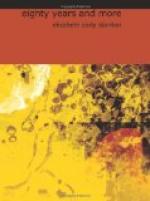When Part I. of “The Woman’s Bible” was finally published in November, 1895, it created a great sensation. Some of the New York city papers gave a page to its review, with pictures of the commentators, of its critics, and even of the book itself. The clergy denounced it as the work of Satan, though it really was the work of Ellen Battelle Dietrick, Lillie Devereux Blake, Rev. Phebe A. Hanaford, Clara Bewick Colby, Ursula N. Gestefeld, Louisa Southworth, Frances Ellen Burr, and myself. Extracts from it, and criticisms of the commentators, were printed in the newspapers throughout America, Great Britain, and Europe. A third edition was found necessary, and finally an edition was published in England. The Revising Committee was enlarged, and it now consists of over thirty of the leading women of America and Europe.[A]
The month of August, 1895, we spent in Peterboro, on the grand hills of Madison County, nine hundred feet above the valley. Gerrit Smith’s fine old mansion still stands, surrounded with magnificent trees, where I had played in childhood, chasing squirrels over lawn and gardens and wading in a modest stream that still creeps slowly round the grounds. I recalled as I sat on the piazza how one time, when Frederick Douglass came to spend a few days at Peterboro, some Southern visitors wrote a note to Mr. Smith asking if Mr. Douglass was to sit in the parlor and at the dining table; if so, during his visit they would remain in their own apartments. Mr. Smith replied that his visitors were always treated by his family as equals, and such would be the case with Mr. Douglass, who was considered one of the ablest men reared under “The Southern Institution.” So these ladies had their meals in their own apartments, where they stayed most of the time, and, as Mr. Douglass prolonged his visit, they no doubt wished in their hearts that they had never taken that silly position. The rest of us walked about with him, arm in arm, played games, and sang songs together, he playing the accompaniment on the guitar. I suppose if our prejudiced countrywomen had been introduced to Dumas in a French salon, they would at once have donned their bonnets and ran away.
Sitting alone under the trees I recalled the different generations that had passed away, all known to me. Here I had met the grandfather, Peter Sken Smith, partner of John Jacob Astor. In their bargains with the Indians they acquired immense tracts of land in the Northern part of the State of New York, which were the nucleus of their large fortunes. I have often heard Cousin Gerrit complain of the time he lost managing the estate. His son Greene was an enthusiast in the natural sciences and took but little interest in property matters. Later, his grandson, Gerrit Smith Miller, assumed the burden of managing the estate and, in addition, devoted himself to agriculture. He imported a fine breed of Holstein cattle, which have taken the first prize at several fairs. His son, bearing the same name, is devoted to the natural sciences, like his uncle Greene; whose fine collection of birds was presented by his widow to Harvard College.




